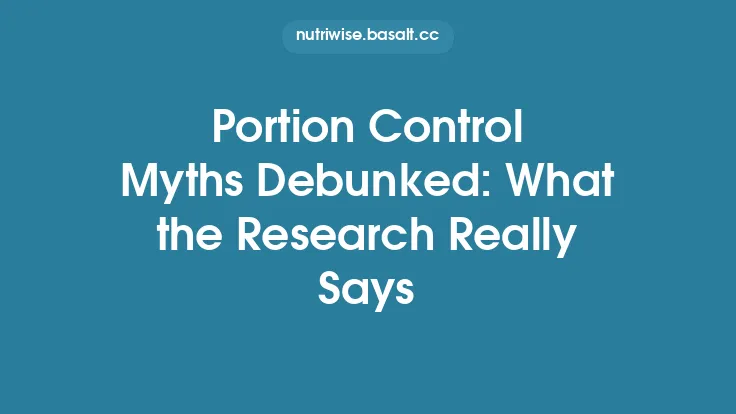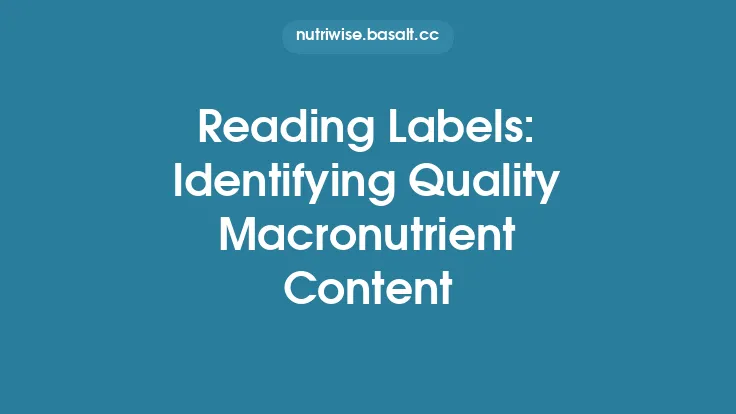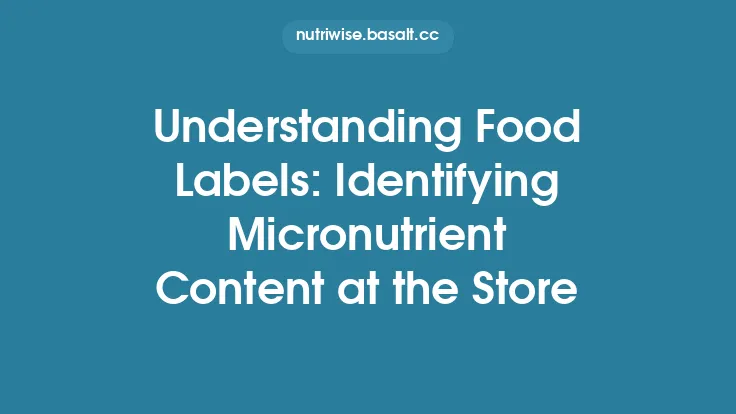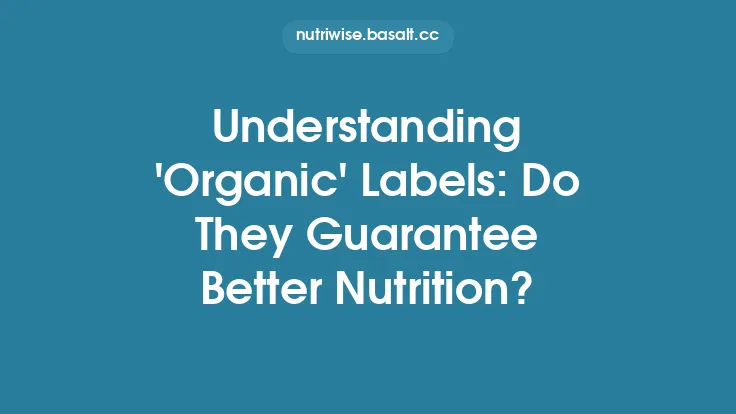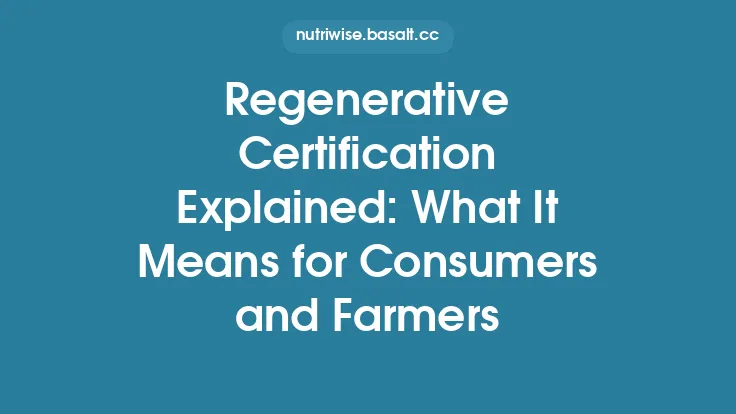Animal welfare certifications have become a familiar sight on grocery shelves, promising that the meat, poultry, eggs, or dairy products we purchase come from farms that treat animals with a higher standard of care. Yet, the proliferation of labels can leave shoppers wondering which ones truly reflect meaningful improvements in animal well‑being and which are merely marketing tools. This article unpacks the landscape of animal‑welfare certifications, explains how they are developed and enforced, and offers practical guidance for interpreting the symbols you encounter in the marketplace.
Why Certifications Matter
Consumer Trust and Market Incentives
When consumers express a willingness to pay more for products that meet higher animal‑welfare standards, producers have a financial incentive to adopt practices that qualify for certification. Certifications therefore serve as a bridge between consumer values and farm‑level decisions, translating abstract ethical concerns into concrete market signals.
Standardization Across Diverse Production Systems
Animal‑welfare practices can vary dramatically between species, production systems, and geographic regions. A certification program provides a standardized set of criteria that can be applied consistently, allowing buyers to compare products from different farms or even different countries on a common baseline.
Transparency and Traceability
Many certification schemes require detailed record‑keeping and third‑party verification, creating a documented trail from farm to fork. This traceability helps regulators, retailers, and consumers verify that the claimed standards have been met throughout the supply chain.
Major Animal‑Welfare Certification Programs
Below is a snapshot of the most widely recognized certification schemes, grouped by geographic focus and scope. While each program has its own nuances, they share a common goal: to ensure that farmed animals experience a baseline level of physical health, appropriate behavior, and humane treatment.
| Certification | Geographic Scope | Primary Species Covered | Tier Structure | Governing Body |
|---|---|---|---|---|
| Certified Humane | United States, Canada | Poultry, eggs, pork, beef, lamb, dairy | Single tier (all‑or‑nothing) | Humane Farm Animal Care (HFAC) |
| Animal Welfare Approved (AWA) | United States, Canada | Beef, pork, lamb, poultry, eggs, dairy | Single tier (all‑or‑nothing) | A Greener World (AGW) |
| Global Animal Partnership (GAP) | International | Beef, pork, poultry, eggs, dairy | Five‑level tiered system (Levels 1‑5) | GAP |
| RSPCA Assured | United Kingdom | Poultry, pork, beef, lamb, dairy, eggs | Single tier | Royal Society for the Prevention of Cruelty to Animals |
| EU Organic | European Union | All livestock species | Single tier (organic + welfare) | European Commission |
| USDA Organic | United States | All livestock species (with additional welfare provisions) | Single tier (organic + welfare) | United States Department of Agriculture |
| Certified Sustainable (various national schemes) | Country‑specific (e.g., Canada’s “Certified Sustainable Beef”) | Species‑specific | Often single tier | National agricultural agencies or NGOs |
*Note:* Some certifications, such as USDA Organic, incorporate animal‑welfare criteria as part of a broader set of environmental and health standards. Others, like GAP, focus exclusively on welfare and provide a graded scale that allows farms to progress toward higher levels of care.
Understanding the Criteria
Core Welfare Domains
Most certification programs evaluate farms against the “Five Freedoms” framework, which has been adapted into measurable criteria:
- Freedom from Hunger and Thirst – Access to clean water and nutritionally adequate feed.
- Freedom from Discomfort – Appropriate shelter, bedding, and space allowances.
- Freedom from Pain, Injury, or Disease – Preventive health care, humane handling, and timely veterinary intervention.
- Freedom to Express Normal Behavior – Access to outdoor areas, enrichment, and social interaction.
- Freedom from Fear and Distress – Low‑stress handling, minimal use of painful procedures, and humane slaughter practices.
Quantitative Benchmarks
Certification bodies translate these domains into specific, auditable metrics. Examples include:
- Space Requirements: Minimum square footage per animal (e.g., 2.5 sq ft per broiler chicken in a grow‑out house).
- Outdoor Access: Minimum percentage of the flock allowed to graze or roam outdoors for a set number of hours per day.
- Enrichment Items: Presence of perches, pecking blocks, or rooting materials for poultry and swine.
- Health Monitoring: Frequency of veterinary checks, disease surveillance protocols, and mortality thresholds (e.g., <5 % cumulative mortality for a production cycle).
- Procedural Restrictions: Prohibitions on routine beak trimming, tail docking, or dehorning without anesthesia.
Tiered vs. All‑or‑Nothing Approaches
- All‑or‑Nothing (Single Tier): Farms must meet every criterion to receive the label. Failure in any single metric results in disqualification.
- Tiered Systems: Programs like GAP assign levels based on the proportion of criteria met, allowing farms to demonstrate incremental improvement. For instance, Level 2 may require basic space and health standards, while Level 5 adds extensive outdoor access and enrichment.
The Certification Process: From Application to Audits
- Pre‑Application Self‑Assessment
Producers review the certification handbook, conduct an internal audit, and identify any gaps. Many programs provide a checklist or online tool to facilitate this step.
- Formal Application
The farm submits an application, including detailed farm maps, animal inventory, and standard operating procedures (SOPs). Application fees vary widely, ranging from a few hundred dollars for small operations to several thousand for large integrated enterprises.
- Initial On‑Site Audit
A third‑party auditor—often an independent certification body accredited by the program—visits the farm. The audit includes:
- Document Review: SOPs, feed records, veterinary logs.
- Physical Inspection: Verification of space allowances, bedding quality, enrichment devices, and water systems.
- Animal Observation: Assessment of animal behavior, health status, and handling practices.
- Sampling: Random sampling of feed, water, and sometimes tissue to verify compliance with ancillary standards (e.g., no prohibited antibiotics).
- Audit Report and Corrective Action Plan
The auditor issues a report highlighting any non‑conformities. The farm must submit a corrective action plan (CAP) within a stipulated timeframe (often 30 days). The CAP outlines steps, responsible personnel, and target dates for remediation.
- Certification Decision
If the CAP is approved and subsequent verification shows compliance, the certification body issues the label. Certification is typically valid for one year, after which a surveillance audit is required.
- Surveillance and Continuous Monitoring
Unannounced spot checks may be conducted to ensure ongoing compliance. Some programs also require annual self‑reporting of key metrics (e.g., mortality rates, space usage).
- Renewal
At the end of the certification cycle, the farm undergoes a full re‑audit. Continuous improvement is encouraged, especially in tiered systems where farms can aim for a higher level.
Reading Labels: What Consumers Should Look For
Identify the Certifying Organization
The logo alone is insufficient; locate the full name of the certifying body (e.g., “Certified Humane” vs. a generic “Humane” claim). Reputable programs are usually listed on the organization’s website with searchable farm directories.
Check for Tier or Level Indicators
If the label includes a level (e.g., “GAP Level 4”), understand what that level entails. Higher levels generally mean stricter standards, but the specific criteria can differ between programs.
Look for Date Stamps or Batch Numbers
Some certifications require a batch or lot number that can be cross‑referenced with the certifier’s online database to confirm that the specific product was produced under the certified conditions.
Beware of “Certified Organic” Alone
While organic standards prohibit certain practices (e.g., routine antibiotics), they do not guarantee high animal‑welfare outcomes beyond basic space and outdoor access requirements. If animal welfare is a priority, seek an additional welfare label.
Verify Third‑Party Verification
Labels that state “Third‑Party Certified” indicate that an independent auditor performed the assessment, reducing the risk of conflict of interest.
Common Misconceptions and Pitfalls
| Misconception | Reality |
|---|---|
| All “humane” labels are equivalent. | Certification standards vary dramatically. For example, “Certified Humane” prohibits beak trimming, while some other “humane” claims may allow it under certain conditions. |
| Higher price always means higher welfare. | Premium pricing can reflect branding, supply chain costs, or organic certification rather than stricter welfare standards. |
| If a product is labeled “free‑range,” it meets high welfare standards. | “Free‑range” is often a minimal legal requirement (e.g., a small outdoor door) and does not guarantee sufficient space, enrichment, or low stocking density. |
| All certifications are government‑run. | Most animal‑welfare certifications are administered by NGOs or private standards bodies, not by governmental agencies. |
| A single audit guarantees lifelong compliance. | Ongoing compliance depends on regular surveillance audits and the farm’s internal monitoring systems. |
Impact of Certifications on Farm Practices
Incentivizing Structural Changes
To meet space or outdoor‑access requirements, many producers have transitioned from intensive confinement systems to more extensive housing designs, such as deep‑litter barns for swine or pasture‑based systems for beef cattle.
Driving Innovation in Enrichment
Certification criteria that mandate behavioral enrichment have spurred the development of low‑cost, farm‑specific solutions—e.g., hanging ropes for pigs, perches for laying hens, or rooting mats for broilers.
Influencing Supply‑Chain Transparency
Retailers that commit to stocking only certified products often require their suppliers to provide traceability data, leading to broader adoption of digital record‑keeping platforms (e.g., blockchain‑based traceability).
Economic Outcomes for Farmers
While certification can increase production costs (e.g., larger barns, lower stocking densities), many farms recoup these expenses through price premiums, access to niche markets, and reduced veterinary costs associated with better animal health.
Critiques and Limitations of Current Systems
- Variability in Stringency
The lack of a universal baseline means that a “Certified Humane” product in the United States may not be directly comparable to a “RSPCA Assured” product in the United Kingdom.
- Potential for “Certification Fatigue”
Small producers may find the administrative burden of multiple certifications prohibitive, leading to market consolidation among larger operations that can absorb the costs.
- Limited Enforcement in Some Jurisdictions
In regions where certification bodies lack legal authority, enforcement relies on market pressure rather than regulatory penalties, which can reduce compliance incentives.
- Consumer Confusion
The proliferation of logos can overwhelm shoppers, potentially leading to disengagement or reliance on vague “natural” claims that lack verification.
- Focus on Minimum Standards
Many programs certify farms that meet only the baseline criteria, which may still fall short of what animal‑welfare scientists consider optimal (e.g., limited outdoor time for poultry in some “free‑range” certifications).
Future Directions in Animal‑Welfare Labeling
Harmonization of Standards
International collaborations, such as the Global Animal Welfare Standards Initiative, aim to develop a set of core criteria that can be adopted across multiple certification schemes, simplifying consumer choice and reducing redundancy for producers.
Tiered Transparency Platforms
Emerging digital platforms allow farms to publish real‑time welfare metrics (e.g., space per animal, mortality rates) alongside the certification label, giving consumers deeper insight beyond a static logo.
Integration with Environmental Metrics
Next‑generation certifications are beginning to bundle animal‑welfare standards with carbon‑footprint and biodiversity indicators, reflecting the growing consumer demand for holistic sustainability.
Adaptive Auditing Using Remote Sensing
Pilot projects are testing the use of drones and satellite imagery to verify outdoor‑access claims, reducing the need for frequent on‑site visits while maintaining audit integrity.
Consumer Education Campaigns
Industry groups are investing in standardized educational materials (e.g., QR‑code‑linked videos) that explain what each label means, helping shoppers make informed decisions without needing to research each program independently.
Practical Takeaways for the Conscious Consumer
- Look for the full certifying body’s name and verify it on the organization’s website.
- Check for tier or level information and understand the specific criteria associated with that level.
- Prefer third‑party audited labels over self‑declared claims.
- Combine welfare labels with other sustainability indicators (e.g., organic, carbon‑neutral) for a more comprehensive assessment.
- Stay informed about emerging standards and digital traceability tools that can provide deeper insight into farm practices.
By developing a clear understanding of what animal‑welfare certifications actually entail, you can turn the myriad of labels on supermarket shelves into reliable guides that align your purchasing power with the ethical treatment of farmed animals. This not only supports farms that are committed to higher standards but also drives the broader industry toward more humane, transparent, and sustainable practices.

